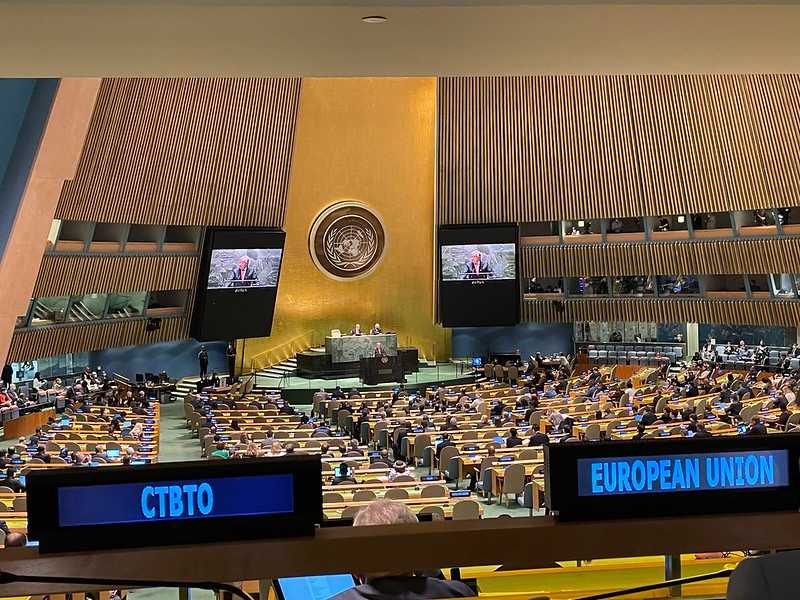According to some experts, the EU has traditionally adopted a rather conservative approach of strengthening existing regimes.6 As a matter of fact, the EU does not envision policies directly addressing nuclear proliferation, but rather limits its scope of action to promoting regional stability in nuclear weapon states. Moreover, the EU has yet to translate its non-proliferation objectives stated in high-level documents into its regional approaches, as in the case of Iran.
The EU has affirmed its primary objective within the nuclear non-proliferation regime as the reinforcement of the regime itself through active support for the success of the NPT Review Conferences (RevCons), which the Union recognises as a significant platform to promote awareness of its non-proliferation policy. Since the 1990s, the EU has consistently endeavoured to coordinate the positions of its member states during the RevCon through joint statements and working papers, in addition to individual member states’ contributions.
Assessments of the EU’s performance in the context of the NPT review are varied. Some experts commend its consensus-building role and improved coordination of member states’ positions, and consider the EU a champion of the NPT.7 However, the prevailing perception is that the EU’s stance towards the NPT is low profile and passive8, and that the Union has not achieved major successes within the NPT framework.9
The complexity of the RevCons is a significant challenge for the EU, given the diverse interests of 190 state parties and the strategic concerns underlying the discussions. The EU lacks the competence to act on behalf of its member states in this forum, and it is not a member of the NPT itself.10 Moreover, the EU comprises both NWS and NNWS, each with their own sovereign nuclear interests, which can be highly divergent, thus further highlighting the heterogeneity of preferences within the EU.11 These factors contribute to the complexities and limitations faced by the EU in its efforts to achieve significant progress within the NPT framework.

Online resources:
Arms Control Association: A nonpartisan organization promoting public understanding and support for effective arms control policies.
Website: https://www.armscontrol.org
Nuclear Threat Initiative (NTI): A nonprofit organization focused on reducing the threats from nuclear, biological, and chemical weapons.
Website: https://www.nti.org
International Campaign to Abolish Nuclear Weapons (ICAN): A coalition advocating for the elimination of nuclear weapons, awarded the Nobel Peace Prize in 2017.
Website: https://www.icanw.org
United Nations Office for Disarmament Affairs (UNODA): A UN office promoting nuclear disarmament and non-proliferation.
Website: https://www.un.org/disarmament
Federation of American Scientists (FAS): Provides analysis and resources on nuclear weapons policy, disarmament, and non-proliferation.
Website: https://fas.org/issues/nuclear-weapons
Bulletin of the Atomic Scientists: Offers expert analysis on global security issues, including nuclear risk.
Website: https://thebulletin.org
Center for Nonproliferation Studies (CNS): Dedicated to combating the spread of weapons of mass destruction.
Website: https://nonproliferation.org
Carnegie Endowment for International Peace – Nuclear Policy Program: Provides insights and policy solutions to address nuclear risks.
Website: https://carnegieendowment.org/programs/npp
Ploughshares Fund: Supports initiatives to prevent the spread and use of nuclear weapons.
Website: https://ploughshares.org
Council on Foreign Relations (CFR) – Nonproliferation, Arms Control, and Disarmament: Offers analysis on global efforts to control and eliminate weapons of mass destruction.
Website: https://cfr.org/nonproliferation-arms-control-and-disarmament
Union of Concerned Scientists – Nuclear Weapons & Global Security: Focuses on reducing the risk of nuclear war and promoting policies for a safer world.
Website: https://ucsusa.org/nuclear-weapons
Pugwash Conferences on Science and World Affairs: An international organization working to reduce armed conflict and seek solutions to global security threats.
Website: https://pugwash.org
International Atomic Energy Agency (IAEA): Promotes the peaceful use of nuclear energy and prevents its use for military purposes.
Website: https://www.iaea.org
Reaching Critical Will – Women’s International League for Peace and Freedom: Provides information and resources on disarmament initiatives, focusing on nuclear weapons.
Website: https://reachingcriticalwill.org
Footnotes
-
https://www.consilium.europa.eu/media/30823/qc7809568enc.pdf ↩
-
https://www.eeas.europa.eu/sites/default/files/documents/st_15708_2003_init_en.pdf ↩
-
https://www.eeas.europa.eu/delegations/un-new-york/eu-statement-%E2%80%93-10th-review-conference-treaty-non-proliferation-nuclear_en?s=63 ↩
-
https://www.ucm.es/data/cont/media/www/pag-72491/UNISCI%20DP%2030%20-%20DEE.pdf; https://link.springer.com/chapter/10.1057/9781137378446_6 ↩
-
https://www.tandfonline.com/doi/epdf/10.1080/03932729.2010.519543?needAccess=true&role=button ↩
-
European Union Non-Proliferation Policies Before and After the 2003 Strategy: Continuity and Change | SpringerLink ↩
-
https://www.ucm.es/data/cont/media/www/pag-72491/UNISCI%20DP%2030%20-%20DEE.pdf ↩
-
https://www.ucm.es/data/cont/media/www/pag-72491/UNISCI%20DP%2030%20-%20DEE.pdf ↩
